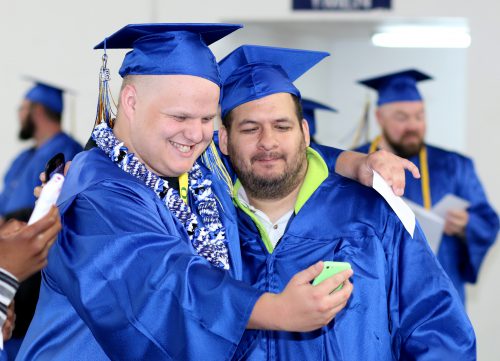This content was published: April 17, 2017. Phone numbers, email addresses, and other information may have changed.
PCC looks down new pathways to improve completion rate
Photos and story by Katherine Miller
 Lagging completion rates for students have been an ongoing challenge for many community colleges nationwide, including PCC. At most schools, the number of first-time, full-time students who earn a certificate, two-year degree or transfer to a four-year college within three years is between 30 and 40 percent.
Lagging completion rates for students have been an ongoing challenge for many community colleges nationwide, including PCC. At most schools, the number of first-time, full-time students who earn a certificate, two-year degree or transfer to a four-year college within three years is between 30 and 40 percent.
As part of its efforts to address this issue, PCC’s campus presidents invited Rob Johnstone, founder and president of National Center for Inquiry and Improvement, to give presentations for faculty, academic professionals and staff at all four campuses on how the most promising strategy may be to move from the traditional “cafeteria” model to a “guided pathways” approach.
Johnstone is a long-time educator and consultant who works with colleges to create system-level changes that improve completion rates and ensure equitable access. This year he is consulting for the Oregon Student Success Center through the Oregon Community College Association.
At one of his recent visits at PCC he explained that the landscape of higher education remained much the same for hundreds of years. But after the GI Bill was passed following World War II, the U.S. greatly expanded its community college system, which had the benefit of democratizing higher education and attracting a broader spectrum of students than those typically served at elite schools.
However, lower-income students are enrolled in much higher numbers at community colleges and four-year state schools than at elite universities. And many educators and have begun to understand that the cafeteria model doesn’t necessarily serve them well.
Traditionally, this model has offered a large selection of curriculum options. At community colleges – with their different certificate, degree and transfer options – the choices are even more overwhelming than at four-year schools. Students often take many terms to decide on a study track, sometimes enrolling in classes that ultimately don’t advance their degree requirements or career goals.
“We make it really easy to dip your toe in the water, take some courses and figure out (the outcome) later. The problem is, many of those students are not on track to anything,” said Johnstone.
He explained that the cafeteria model worked well enough for affluent students because they typically have parents who attended college, don’t have financial pressures, and have high social capital. But students from low-income homes are often the first in their family to attend college, have financial hardships, and, in the case of minorities, face barriers of equality.
 Many lower-income students may also lack confidence that they’re “college material,” something that Johnstone said is often reinforced by requiring them to take college English and math placement tests, which ultimately fail to serve most students’ educational goals.
Many lower-income students may also lack confidence that they’re “college material,” something that Johnstone said is often reinforced by requiring them to take college English and math placement tests, which ultimately fail to serve most students’ educational goals.
In addition, for many lower-income students, college is a vehicle for economic mobility to a better life, he said. They want to complete certificates and degrees in a timely and cost-effective manner, something the traditional model isn’t designed to support. The myriad choices, coupled with the lack of clear career paths and paucity of academic monitoring and support, can make it difficult for them to stay on track and complete their studies.
Johnstone said that there are two notable exceptions to this scenario: athletes and career technology students. Athletes are given clear expectations; coaches keep them on track academically; and teammates provide peer pressure and support. Also, athletes have a limited window of eligibility to compete, so they’re motivated to complete their studies.
Students in cohort-based Career and Technical Education (CTE) programs also do well because they have well-defined curricula with clear career outcomes, and sustained contact with faculty and peers.
Giving other students the same level of structure, accountability and support is what is at the heart of the guided pathways movement.
“We’re not trying to get rid of choice, we’re trying to architect it. We’re trying to get people to make informed choices. We’re trying to let them to choose from a number of structured choices.”
Although Johnstone said guided pathways is relatively new and that more research is needed, there is strong evidence that the model is effective. One of the biggest success stories is Georgia State University, which over the last 10 years has redesigned programs and services to create clear curricular pathways to employment and further education, help students start early on a path, and monitor and support their progress. The result is that since 2007, Georgia State’s graduation rate has gone from 32 percent to 50 percent for whites; 26 percent to 56 percent for African Americans; and 22 percent to 55 percent for Hispanics.
“Everyone got notably better,” said Johnstone. ”That so called achievement gap that was apparently about the students? It apparently wasn’t about the students. It was about us. It was about the system. … The students changed their behavior in response to the changes to the system.”
Georgia State’s dramatic improvement occurred without decreasing academic quality, without increasing funding, and without changes in student SAT scores.
“What’s this story about? It’s about sustained leadership, sustained change over time, not giving up the first year,” he said. “What it should result in down the road over time is more students who start at PCC reaching their goals and earning what they came here for, which is a bridge to a family-sustaining wage, a bridge out of poverty for many of them and economic sustainability.”
Sandra Fowler-Hill, president of the Rock Creek Campus, said PCC leadership feels Johnstone’s work supports the current inquiries and initiatives the college is already undertaking with education reform. Johnstone will visit PCC again soon, when conversations about student success and guided pathways continue and PCC considers specific follow-up steps.

